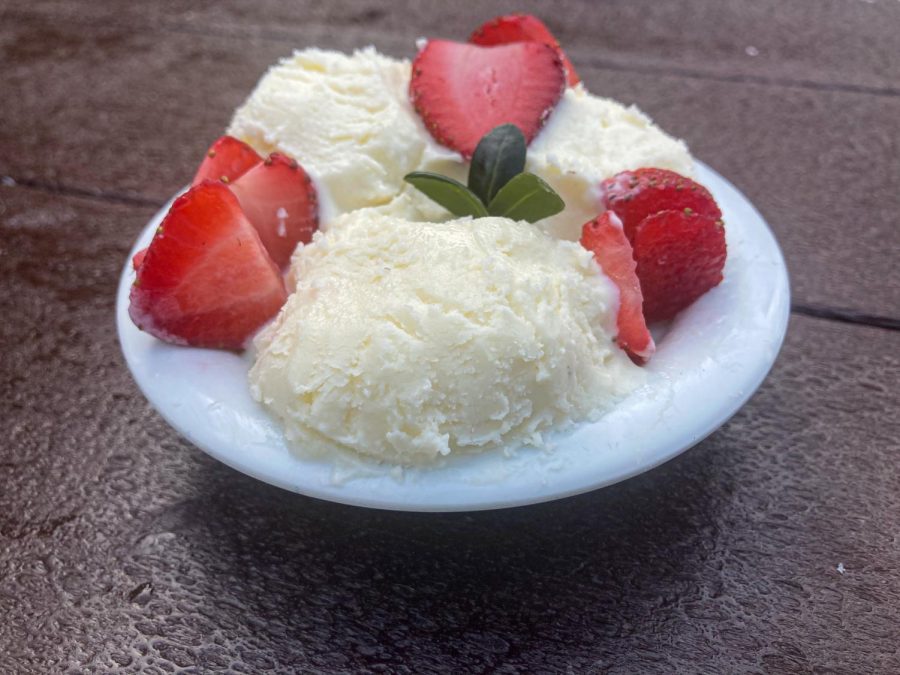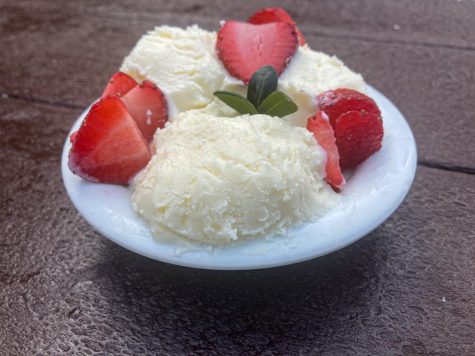Choosing healthy and delicious ice cream
Recipe (from Olga Shobutinskaya)
Ingredients:
1 pint / 473 ml of whipping cream (33-35% fat content)
9.5-11 ounces of sweetened condensed milk
1 teaspoon vanilla sugar (optional)
For strawberry flavor: 300 grams/10.5 ounces strawberries
For chocolate flavor: 20 grams/2-3 tablespoons cocoa powder
Servings: 4
Prep time: 8 hours
Preparation:
- In a large bowl, whip a pint of whipping cream with an electric mixer or a whisk for about 5 minutes until it thickens and the peaks are stiff when you take the whisk out.
- Whisk in the sweetened condensed milk.
- You can also add vanilla sugar teaspoon by teaspoon to taste.
- If you want strawberry flavor, repeat the first steps. Mash 10.5 ounces of strawberries and cook in the pot until all the water has evaporated. It prevents ice cream from having big ice crystals and leads to a smooth texture. Mix it together with the cream and sweetened condensed milk after it has been whipped.
- For the chocolate flavor, start with the same mixture as for the vanilla flavor. Mix it with 20 grams of cocoa powder.
- Pour into a large container, seal it, and put in the freezer for 8-10 hours. Do not forget to stir every hour or two until it is completely frozen to make sure there will be no noticeable ice crystals when it is ready.
Ice cream is probably one of the most popular desserts in the U.S. According to “On Food and Cooking” by Harold McGee, its history goes as far back as the early 17th century. It originated in Italy and then reached France and England. As the new techniques of making the dessert and a huge variety of flavors were introduced, it won the love of more and more people around the globe, including my family in Ukraine.
When my mom, my sister, and I went to the grocery store in the summer, we always checked out the ice cream section. It was our consolation on the long walk home under the blazing sun of late June. The bags with groceries left marks on our hands, and we had to constantly switch between the hand that holds the cone and the hand that holds bags. The screaming children drove past us on their scooters and bicycles, and we wished we had one too. Not a single cloud was in the sky: only an immense expanse of saturated light blue. The melting ice cream did not bring the desirable coldness, but we still savored its lingering vanilla taste on our tongues.
My family’s love for ice cream inspired me to research the process of making it. I wondered why the commercial ice cream included so many ingredients when it was supposed to be made of cream, milk, and sugar. I set out to find out what the healthiest store-bought options were.
The answer to so many ingredients lies in an effort to make the texture of the ice cream smoother, to prevent spoiling and also to make the production process cheaper. As McGee explained in his book, over the years, the manufacturers learned to add gelatin, concentrated milk solids, milk from surplus production, and artificial flavors and colors to the original mixture. The variety of ingredients and brands raises a question of how to choose the best ice cream from all the hundreds of different options in the store.
The most important consideration when buying any food is the product’s potential impact on your health. Of course, ice cream is generally not considered healthy food as it has few nutrients and contains many calories (even the low-fat or no-sugar-added options). However, according to Elizabeth DeRobertis, a registered dietitian with a masters degree in Clinical Nutrition, ice cream has more nutritious value than other treats.
“If someone is thinking about having ice cream or they are thinking about having something like Twizzlers, a regular candy does not really have nutritional advantages, but ice cream does,” she said. “It has some protein, it has calcium which is good for your bones, and it has vitamin D, which is also good for your bones.”
However, it is important to remember that ice cream has sugar, and consuming a lot of sugar might cause heart disease, diabetes, fatty liver disease, and obesity. That’s why DeRobertis is a supporter of an 80/20 concept.
“We eat in a healthy, mindful way 80% of the time, and by doing that we have 20% flexibility to spend extra calories or extra fat on things that are really worth it to us,” she explained. “So if someone says I love ice cream; I grew up eating ice cream, then that ice cream deserves to be in their 20%. It’s just prioritizing what’s really worth it to you.”
DeRobertis also pointed out another downfall of ice cream — saturated fat. She commented, “Saturated fat is the kind of fat that has been found to build up plaque in our arteries and can lead to high cholesterol and heart diseases.”
Despite the fat and sugar content, one can still choose a delicious and relatively healthy ice cream. Another advice DeRobertis offered is to check for artificial sweeteners, especially in the ice cream labeled sugar-free. As to why, the jury is still out on what the long-term effects of these products can be, but for DeRobertis, they just cause a funny aftertaste. Examples include aspartame, sucralose, and ACE K. Some of the healthier sweetener alternatives are monk fruit or erythritol.
Besides looking for the specific ingredients, it can be useful to check how long the ingredient list is.
“I think the shorter list of ingredients generally is a good thing,” DeRobertis said. “But even if the ingredient list is a bit longer, but it is still low in calories, low in saturated fat, we should at least be able to identify what ingredients are on the list.”
As for the brands, DeRobertis had many suggestions. She said that Breyers and Ben&Jerry’s usually have fewer ingredients, and Nick’s is a lower-calorie option without many artificial additives. She also mentioned Yasso, an ice cream made from yogurt that does not have artificial sweeteners and has only 100 calories, and Enlightened (not the keto version, but regular Enlightened), which is low in calories and saturated fat and a little lower in carbohydrates without having artificial sweeteners.
Another option, and my favorite one, is to make ice cream yourself. Last year, my mom discovered a recipe for home-made ice cream online. As it was extremely easy to prepare, we were pleasantly surprised to find it turned out to be quite delicious and even better than some of the commercial ice cream we tried. Since then, we have a new tradition: buy the necessary ingredients in the store and prepare our favorite dessert at home.
DeRobertis agreed that home-made ice cream can be somewhat healthier. She said, “One nice thing about home-made food is that it takes a little more time and work, so it’s a more thoughtful food decision. I think sometimes when people are not eating in such a healthy way, it’s because a lot of their choices are impulsive. Home-made ice cream still could end up high in calories and saturated fat, but I do think that there is something about it overall that could be healthier because there won’t be any preservatives or any hidden ingredients.”
Try making it as well and determine for yourself which ice cream you like better: the home-made one or the store-bought version.










